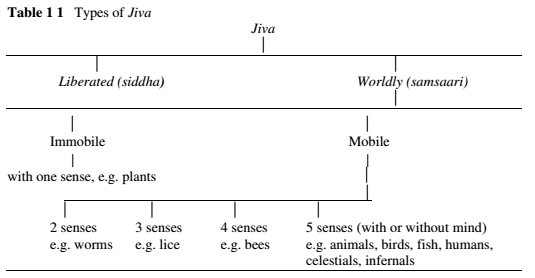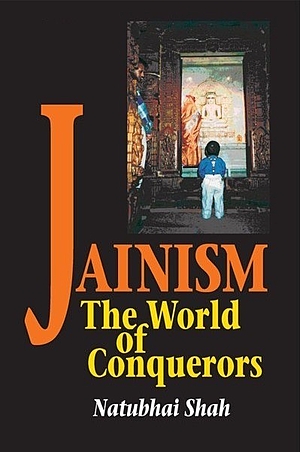Let me introduce you to Jainism by greeting you in a Jain way, Jai Jinendra. This greeting literally means: 'honour to those who have conquered themselves'. By this, Jains mean honour to those who have conquered their inner impulses, whether good or evil, and who exemplify the path of self-conquest and happiness to all other living beings.
Life is dear to us all - human beings and other living beings, happy individuals as well as unhappy ones. Many questions about life arise in our minds. Who has given us life? Who takes it away when we die? Why are there injustices in life? Why are some born into poor families and others born into wealthy ones? Why are some born as humans and others born as animals? Why one is male and another is female? Why do some live a long life and others a short one? Why are some born with great intellectual gifts, while others are less well endowed? Can we explain why some are born with physical attributes, which are prized, such as beauty, while others lack these? Why is one person healthy and another full of suffering? Why do some achieve popularity and fame yet others are unpopular or even notorious? Why do some people have great wealth, while others cannot make ends meet?
The more we think, the more questions come into our inquisitive minds. Do our lives have meaning? Do they have purpose? Can we achieve permanent happiness and bliss? Who are we? Where have we come from? And what are we here for?
For endless centuries these questions have puzzled all thinking people, philosophers, theologians and the scientists. They have sought answers, postulated theories and have attempted to find the truth about these great mysteries and the nature of the universe. Some believe it is the will of the Almighty 'Supreme God', the creator, the sustainer and the dispenser of justice. Others maintain that the universe is eternal and the mysterious phenomena of nature, justice and injustice, are the results of karmic bondage of the soul. Our own actions in the past, whether good or bad, cause this karmic bondage, which we will discuss in detail later.
Jain tradition
Indian civilisation has produced many philosophies and religions. Among them is Jainism, one of the oldest religions in the world. Jainism is a religion, a philosophy, and a way of life taught and preached in the past by countless Jinas (and which will be taught in the future by further Jinas). Though historians have made various speculations about its origins, the origin of Jainism remains untraceable. Jains believe it to be an eternal religion. The name Jainism comes from Jina, meaning 'victor' in the classical Indian language Sanskrit. Jinas are the victors over the self, have achieved liberation from karmic bondage and they have attained the true characteristics of the soul such as infinite faith, infinite knowledge, perfect conduct, infinite bliss and eternity by their own efforts. They are called tirthankaras, those who lead us towards the path of the eternal life of perfection. Tirtha means pilgrimage, (spiritual) path, or the order, which follows this path. Each tirthankara establishes four orders of society (caturvidha sangha) consisting of monks (saadhus), nuns (saadhvis), male lay followers (sraavakas) and female lay followers (sraavikaas).
rs (sraavikaas). The tirthankara leads the above four orders of society towards the path of spiritual perfection by teaching the truth about the universe and its nature, the meaning of life and the ethical path to be pursued. When Jains say that Jainism is a religion preached by the Jinas, they mean Jainism expresses the eternal truths of life and spirituality taught by pure souls, who are victors of themselves, with perfect knowledge and understanding.
Jainism believes the universe to be eternal, its constituents such as living and non-living things may change form, but they are basically eternal. Time rotates in a cycle, like a wheel moving clockwise, descending and ascending. In each half of the time cycle (aeon), descending and ascending, twenty-four tirthankaras establish the fourfold order and teach the path of happiness and perfection to all the living beings of the world. The first tirthankara in this aeon was Risabhdeva and the twenty-fourth (and last) was Vardhamana Mahavira who lived, according to generally accepted dates, from 599 to 527 BCE. (Jain K C 1991: pp 84-88)
Revival of Jainism
The last tirthankara Mahavira is not the founder of Jainism, but he revived and expounded the religious, philosophical and ethical teachings of previous tirthankaras. Jains believe that Jainism belongs to the non-Vedic, sramana tradition of Indian culture and is reputed to be pre-Vedic, antedating the coming of the Aryan peoples to India. Over a period of nearly a century after Mahavira's liberation, Jainism produced a series of omniscient. These were followed in succession, for more than two centuries, by scriptural omniscient and later by prominent ascetic scholars. These knowledgeable ascetics evolved Jainism into a complete religious system, with its own philosophy, ethics, rituals and mythology. They produced a vast sacred literature covering all aspects of human life and the situation of other living beings in the universe.
Mahavira was very practical in his approach. He divided society into male ascetics and female ascetics, who can follow his teachings rigorously, and laymen and laywomen who can pursue the path of his teachings to the best of their abilities in the light of their worldly duties. Jainism does not demand unquestioning faith from its followers, but encourages understanding before acceptance.
The fourfold order developed into a highly organised society of monastic orders and laypeople. Jains have created beautiful temples, upashrayas (places of meditation), and preserved most of their sacred literature. They have established institutions of education, social welfare and animal welfare. 'Live and help to live' is their motto and their way of life is based on the teachings of Mahavira.
Mahavira was a contemporary of the Buddha. Both of them preached religions that stemmed from the sramana tradition. Buddha founded Buddhism in the sixth century BCE, while Jainism has existed in India for much longer. They believed sacrifices and other religious practices conducted by brahmanical priests not only unnecessary, but a hindrance to the goal of moksa or nirvana (liberation). The way to liberation, they claimed, was through self-discipline, meditation and ascetic practices. The similarities between the Jain and Buddhist religions, and especially the fact that Mahavira and the Buddha lived at the same time in the same region, caused confusion among Western scholars for a long time, but there are basic differences in the beliefs of Jainism and Buddhism.
Jainism believes in the equality of all souls and reverence for life in its totality. It accords significance to the minutest living organisms. Animal welfare, vegetarianism and care of the environment are very much at the heart of Jain beliefs. Relative pluralism has made Jains tolerant towards other faiths and has kept Jainism as an 'open' religion. Whereas Buddhism has missionaries and seeks converts, Jainism has not followed the path of active conversion.
Buddhism believes in the impermanence of the world and that everything is also transitory, which is totally counter to Jain belief that the universe and everything in it are real and permanent; the modes of the 'real entity' change, but the 'real entity' or the substance are permanent. Buddhism believes the soul to be a series of continuous unbroken instants of consciousness: it is an illusion. Jainism believes the soul as an eternal 'real entity', which has consciousness as one of its attributes; the soul keeps its individuality even after liberation.
Karma is very fine particles of matter according to Jain belief, while it is merely a force according to Buddhism.
Jainism prescribes a programme of spiritual training far more rigorous than the middle path of Buddhism and the fourfold order of Jainism does not exist in Buddhism.
Jain daily practices of ascetics, the temples, the rituals and the duties of laity differ from those of Buddhism. The life of Jain ascetics is much more austere than that of Buddhist monks. Jains have remained strict vegetarians. Buddhists are also vegetarians, but in other Buddhist traditions meat eating has become permissible, though Buddhists would not undertake the slaughter of animals themselves, nor accept meat slaughtered or cooked specially for them. Both religions have given importance to asceticism. Buddhism accepts temporary asceticism, whereas in Jainism it is permanent.
Jainism is a highly original system of thought containing ancient material. The two religions, though similar in origin and approach, evolved along different lines and each gathered a vast number of followers. But Jainism, unlike Buddhism, spread little beyond the frontiers of India. Its hold over its adherents in India, however, continued to be strong throughout the ages and it was able, therefore, to counter the strong forces of the Hindu revivalists. Buddhism, on the other hand, could not withstand these pressures and consequently virtually disappeared from the land of its origin. Jainism, though restricted to a minority, continues to be a living tradition in India today. Owing to recent migrations, Jain followers are now to be found in most countries of the world.
The Jain way of life is not at odds with normal everyday life. It is an ethical doctrine with self-discipline as its core. It does not recognise an almighty god or a Supreme Being. It believes in godhood that can be attained by most of us, provided we follow the teachings of the Jina and liberate our souls. Jains do not depend on 'divine grace' to attain liberation, but attempt to achieve it through individual initiative and effort. They worship tirthankaras as examples and do not ask for any favours.
Jainism is an open religion. Persons born in the Jain community have to be Jains by following the teachings of the Jinas. They have a better environment to be true Jains. Jainism believes, irrespective of labels attached to us by birth or otherwise, any person who follows the path of the Jinas is a Jain.
Jain teachings
Jainism teaches that the universe consists of living and non-living things. It is the attachment of non-living substances to living things, the soul, which causes suffering, an unending process of birth, death and rebirth. The Jain way of life consists of the coordinated path of the 'Three Jewels': Right Faith, Right Knowledge and Right Conduct. Right Faith is belief in the teachings of the Jinas, Right Knowledge is a proper grasp of the nine real entities making the universe, as found in the teachings of omniscient Jinas, and Right Conduct is the ethical code, behaviour and actions laid down by the teachings of the Jinas.
Jinas. The universe consists of six substances: the soul, matter, the medium of motion, the medium of rest, space and time. The soul is the living being (jiva) and the others are non-living substances (ajiva). Both jiva and ajiva are interdependent and everlasting. Living beings can be categorised into two types: those who are liberated, that is who have successfully freed themselves from the cycle of birth, death and rebirth, and those who are still enmeshed in that cycle (worldly). Whenever the worldly (sansaari) soul appears on earth it is born as either a mobile or an immobile being. The immobile being has only one sense, that of touch. The simplest example is a plant. Mobile beings have the sense of touch and, in addition, one or more of the remaining four senses, taste, sight, smell and hearing. The five-sense living beings are further subdivided into those that have a mind, such as human beings, and those that do not have a mind, such as most animals. This produces a classification like that in Table 1.1 (It should be remembered that the traditional divisions may not accord exactly with those accepted by modern biology).

Causes of The Mysteries of Worldly Life: In the worldly life, living beings have been attached to non-living karma since eternity and this bondage is responsible for birth, death, sufferings, pain and illusory pleasures of a temporary nature. Karmic bondage is the result of our own actions, physical, verbal or mental. The moment the karma is totally shed, the soul becomes liberated and is able to live with its full potentials of infinite bliss, knowledge, faith and spiritual energy, and perfect conduct eternally along with other liberated souls. When one dies, the soul leaves the body, which is made of matter, but takes the karma attached to it. The type of karma forces the soul to create another body according to the characteristics of its particular karma.
Jainism describes karma as subtle matter of sub-atomic particles, not perceptible to the senses, found everywhere in the cosmos and having the property of penetrating the soul and clouding its characteristics. The activities of mind, body and speech create vibrations in these particles and attract them to the soul. Intense activities cause severe vibrations, causing these particles to penetrate the soul and stick to it tightly. The influx of karmic matter occurs all the time. Benevolent acts cause good karma (merit), while sinful acts cause bad karma (demerit). The result of merit is good body, good destiny and family, and material happiness; the reverse is the case with demerit. Both merit and demerit keep the soul in the worldly cycle, they do not cancel each other out. Karmic particles penetrate the soul and form karmic body around the regions of the soul. For liberation from the cycle of birth and death, all karmic particles, whether of merit or demerit, have to be shed.
The quantity, the size, the type and the density of karmic particles determine the form that the soul will assume in forthcoming births. it is the karmic body, which causes the living being to have inherent passions such as greed, anger, deceit and pride. Of course, external environments affect these passions, increasing their severity in a complementary way, but the Right Conduct including ethics, austerities and meditation can prevent this complementary effect.
After the results of the deeds, good and bad, have been worked out in the soul; the karma matter is shed. If this were to continue uninterruptedly then the soul eventually would shed all the karma matter. Unfortunately, this is impossible because while a being is shedding old karmic matter, it is simultaneously attracting new, through different actions of mind, body and speech. Thus the soul remains in bondage to the karmic body and transmigrates through the worldly cycle.
Liberation of the soul from karmic bondage can be achieved only through an active shedding of all existing karma. Jainism describes this as a two-stage process. The first stage is the blocking of all channels through which karma flows into the soul. This requires rigorous self-control and freedom from worldly attachments by cutting oneself off from worldly ties and occupying oneself in meditation. Once the ingress of karma has been blocked, then begins the second stage of shedding the particles of karmic body by austerities begins until the karma is destroyed. When this finally occurs, after countless lives and long spiritual development, the soul, released from its bondage, reverts to its true natural state of pure perfection and attains liberation. It ascends to the apex of the universe where it dwells in siddha silaa, a liberated soul without material body, enjoying infinite bliss, infinite knowledge, detachment and equanimity.
The theory of karma explains almost all the questions raised at the beginning of this chapter, such as the injustice in this world, the type of body one occupies, the misery and unhappiness, and the cycle of rebirth. The answer to the question, 'What am I?' becomes a little clearer. I am a soul, which occupies different types of bodies, which may be celestial, human, subhuman or infernal depending upon the karma attached to it. It is because of karmic bondage that an individual cannot enjoy the true characteristics of the perfect soul: infinite bliss, knowledge and peace, and the goal of life is to achieve it.
Like dirt mixed with gold particles, karmic bondage is attached to the living being from the time immemorial. It is the objective of human life to remove this bondage, achieve self-realisation and restore the soul to its natural state of eternal bliss and unending calm.
Jains argue that most individuals have not understood the true meaning of life. They are on the wrong quest, seeking the so-called ways to happiness through wealth, property, position, power and external objects. The pleasures brought by these material things are temporary, dependent on outside influences and substances that produce more and more desires, greed, pride, egoism, attachment and ultimately unhappiness. Ignorance, uncontrolled desires and activities of mind, body and speech are the causes of the bondage of the soul. The path towards self-conquest is gained if one controls the mind, develops detachment towards external objects, concern for the welfare of living beings, and contemplation on the soul. The happiness, which comes from within by self-conquest is not dependent on any external objects but is self-generated and permanent. To utilise the body for self-realisation and self-conquest is the true meaning of life.
 Dr. Natubhai Shah
Dr. Natubhai Shah
